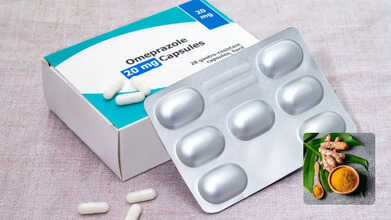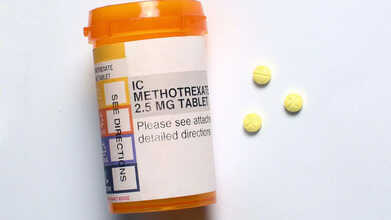- Health Conditions A-Z
- Health & Wellness
- Nutrition
- Fitness
- Health News
- Ayurveda
- Videos
- Medicine A-Z
- Parenting
This Simple Eye Test Could Save You From Stroke, New Study Suggests

Image Credit: Canva
The human eye has long been considered a window to the soul, but modern science reveals its potential for being a diagnostic window toward our health. Researchers have already discovered that in the retina – the light-sensitive layer at the back of the human eye – resides an intricate network of blood vessels that can foretell crucial elements about a person's risk to stroke. This finding is a non-invasive and accessible approach to predicting stroke, hence challenging the dependency on the classic risk factors alone, such as high cholesterol or blood pressure. Recent research published in the journal Heart identified a "vascular fingerprint" in the retina, comprising 29 indicators of blood vessel health.
This fingerprint can predict the likelihood of a stroke with accuracy comparable to conventional methods. These indicators include characteristics like the density, twistedness, and complexity of retinal veins and arteries, which mirror the vascular architecture of the brain.
This innovative approach is particularly promising for primary healthcare settings and resource-constrained environments, where invasive lab tests may not be feasible. The potential to assess stroke risk through a simple retinal scan marks a significant leap in preventive medicine.
The researchers, who include those from The Royal Victorian Eye and Ear Hospital in Australia, analyzed fundus images, which are specialized photographs of the retina from more than 68,000 participants in the UK Biobank dataset. Over an average follow-up period of 12.5 years, 749 of those participants had a stroke.
The researchers used advanced machine learning models, such as the Retina-based Microvascular Health Assessment System (RMHAS), to study 30 indicators in five key categories of retinal vascular architecture.
These categories included calibre, which measured the length, diameter, and ratio of veins and arteries; density, which focused on the distribution of blood vessels in the retina; twistedness, analyzing the curvature and patterns of the vascular network; branching angle, which examined how veins and arteries split into smaller branches; and complexity, which evaluated the overall intricacy of the vascular network. In the study, age, sex, socioeconomic status, lifestyle habits, and health parameters, including blood pressure and cholesterol levels, were taken into account to ensure that the findings were robust. The analysis showed that 29 out of 118 retinal vascular indicators are significantly associated with first-time stroke risk.
Changes in density indicators corresponded to 10-19% increased risks of stroke; alterations in calibre indicators were accompanied by a 10-14% increase. Other studies have suggested that decreases in complexity and twistedness indicators corresponded to a 10.5-19.5% higher risk of stroke. These data support the retinal imaging non-invasive diagnostic tool for prediction of early stroke.
Amazingly, the retinal vascular fingerprint alone, in combination with only age and sex, was as good at predicting stroke risk as traditional methods that rely on invasive tests.
How the Retina is Connected to your Brain
Retinal blood vessels bear anatomical and physiological resemblance to those in the brain. Given this, it is an attractive organ for understanding the systemic health of the vasculature. Many diseases, for example, which damage blood vessels throughout the body, leave evidence in the retinal microvascular network. Diabetic retinopathy and hypertensive retinopathy are examples.
The study does have several limitations with this being an observational research, and so it cannot claim to establish any cause-and-effect relationships. The research was also primarily conducted on whites, which makes the findings a little less generalizable to a diverse population. Future studies would be better in including a range of ethnicities and exploring the risk of stroke associated with the type of stroke.
Simple Method To Detect Stroke Risk
Traditional stroke risk assessment is often confined to blood studies and imaging studies; however, these tools are not freely available in some low-resource settings. Retinal photography provides a completely non-invasive imaging modality. All that will be needed will be a basic photograph of an eye.
It is, therefore, through the introduction of artificial intelligence that has been a game-changer in retinal imaging. Systems like RMHAS rely on machine learning to pick out patterns and biomarkers that the human eye might not identify. Such improvements not only enhance predictive accuracy but also speed up the process while making it more cost-effective.
Also Read: 3 Shocking Stroke Risk Factors You Need To Control NOW
Prevention of Stroke through Early Detection
Stroke is one of the leading global health concerns, causing nearly 100 million cases a year and killing 6.7 million people. The majority of the cases are due to modifiable risk factors, including high blood pressure, poor diet, and smoking. The early warning system could help individuals and healthcare providers act proactively on these risks by providing an early warning system.
The discovery of the vascular fingerprint of the retina as a predictor of stroke risk is a testament to the power of innovative diagnostics. This non-invasive, accessible method may revolutionize stroke prevention, especially in underserved communities. As research continues to refine this approach and broaden its applicability, the eye may soon become an essential tool in safeguarding our brain health.
Every Day Tips to Prevent Stroke and Detect Risks Early
The good news is that strokes can be prevented in most cases by living a healthy lifestyle, coupled with knowing the early warning indicators. Implement these tips daily and prevent your risk for stroke before it gets too late.
- High blood pressure is one of the leading risk factors for stroke. Uncontrolled hypertension can weaken blood vessels, making them more prone to rupture or blockage. Invest in a home blood pressure monitor to check your readings regularly. Maintain a target of 120/80 mmHg by reducing salt intake, staying physically active, and adhering to prescribed medications.
- Unhealthy eating habits, such as diets with high levels of processed foods, saturated fats, and cholesterol, can lead to obesity and blocked arteries. A diet rich in fruits, vegetables, whole grains, lean protein, and healthy fats is key. Include leafy greens, berries, nuts, and fish high in omega-3s, which help maintain cardiovascular health.
- Regular physical activity lowers the risk of high blood pressure, obesity, and diabetes, three leading causes of stroke. Try to engage in at least 150 minutes of moderate-intensity aerobic activity a week. Examples include brisk walking, cycling, or swimming. Also incorporate strength training to help strengthen your blood vessels.
- Smoking harms your blood vessels, promotes blood clots, and reduces the oxygen in your blood. Overconsumption of alcohol can raise your blood pressure and lead to weight gain. Quit smoking with support groups, counseling, or nicotine replacement therapy. Limit your intake of alcohol to moderate levels; that is, one drink a day for women and two for men.
- Unmanaged conditions, such as diabetes, high cholesterol, and atrial fibrillation, significantly increase stroke risk. Work with your healthcare provider to monitor and manage these conditions. For example, maintain blood sugar levels within target ranges for diabetes and take anticoagulants if diagnosed with atrial fibrillation.
- Obesity strains the cardiovascular system and increases the risk for stroke. Have a healthy diet along with regular exercise to have a sustainable weight loss. Small, consistent changes in, say, portion control or simply not having too many sugary drinks may make a big difference.
- As a result of this, dehydration could thicken blood, then clots might form. Drink at least 8-10 glasses of water per day. Include hydrating foods like cucumbers and watermelon in your diet, especially during hot weather or exercise.
- Poor sleep quality increases blood pressure, triggers inflammation, and raises stroke risk. Ensure 7-8 hours of sleep at night. Develop a bedtime routine: reduce screen time, have a regular schedule, and avoid caffeine close to bedtime.
- Acting fast during a stroke can prevent long-term damage and save lives. Learn the FAST acronym:
F: Face drooping
A: Arm weakness
S: Difficulty speaking T: Time to call 911
- Regular medical check-ups can identify and manage stroke risk factors before they lead to a stroke. Make an annual physical to track cholesterol, blood pressure, and other essential health markers. If you have a family history of stroke, discuss retinal imaging or carotid artery screening with your physician.
Retinal vascular fingerprints predict incident stroke: findings from the UK Biobank cohort study. Heart. 2025
Omeprazole Alternative? Experts Point To A Kitchen Spice That May Ease Acid Reflux

Credits: Canva
A doctor has highlighted a common kitchen spice that may work just as effectively as omeprazole in relieving heartburn, acid reflux, and indigestion. Omeprazole is often prescribed for these conditions as a Proton Pump Inhibitor (PPI), helping to reduce the amount of acid produced in the stomach.
About 15% of the UK population takes a PPI like omeprazole. In England alone, over 73 million PPI prescriptions were issued in 2022–23, with omeprazole among the most commonly prescribed.
What Is Omeprazole Used For?
Omeprazole is a drug that lowers the amount of acid the stomach produces. Part of a class of medicines called proton pump inhibitors (PPIs), it is used to treat and prevent a range of acid-related problems, as per Mayo Clinic.
The length of treatment with omeprazole, as advised by your doctor, depends on the condition being treated and the prescribed dosage. Following your healthcare provider’s instructions and completing the full course of medication, even if symptoms improve, is important.
However, long-term use of omeprazole can increase the risk of various health issues, making regular consultations with your GP important, reports the Mirror. Prolonged acid suppression and changes in gut bacteria caused by extended use can result in several complications.
Lower stomach acid can reduce the body’s ability to absorb key nutrients, potentially causing deficiencies in magnesium, vitamin B12, calcium, and iron. Long-term use may also raise the risk of bone fractures and kidney problems. Other possible issues include growths in the stomach, dementia, and liver or heart problems.
Suppressing stomach acid, which normally kills harmful bacteria, can make the body more prone to infections such as community-acquired pneumonia or Clostridioides difficile infection, which causes severe diarrhoea and stomach pain.
Omeprazole Alternative: What Is The Spice, And How Can It Help?
Experts suggest that one kitchen spice could match omeprazole’s effectiveness while avoiding its health risks. Dr Michael Ruscio, DC, DNM, says curcumin, the active compound in turmeric, may be “just as effective,” according to research.
Dr Ruscio, a naturopathic practitioner, clinical researcher, and author, has published work in peer-reviewed medical journals. He is the Chief Health Officer and Head of Research at RIFM, and Founder and CEO of DrRuscio.com.
In a YouTube video for his 145k subscribers, Dr Ruscio explained that curcumin may help manage heartburn and acid reflux without relying on PPIs. He said: “Let me show you an important study demonstrating the power of anti-inflammatory interventions. You’ve probably heard of curcumin, this anti-inflammatory spice. A 2023 randomized control trial compared omeprazole to curcumin at two grams per day for one month.”
Quoting the study, “Curcumin and omeprazole showed similar effectiveness for functional dyspepsia,” a term covering symptoms like fullness, GORD, and indigestion. Dr Ruscio added, “It’s remarkable that curcumin, which also has benefits such as reducing joint pain, can be as effective as omeprazole. And it doesn’t carry the long-term risks of acid suppression that come with omeprazole.”
Curcumin’s anti-inflammatory and antioxidant properties may reduce oesophageal inflammation caused by stomach acid. Animal studies suggest it can protect the stomach lining from damage caused by certain medications and other irritants.
What Did The Study's Findings Reveal?
The referenced research, published in BMJ Journals as “Curcumin and proton pump inhibitors for functional dyspepsia: a randomized, double-blind controlled trial,” found that a daily dose of curcumin provided relief from functional dyspepsia symptoms comparable to omeprazole.
No significant side effects were observed, though liver function tests showed some decline in overweight participants taking curcumin. The researchers noted limitations including the short study period and lack of long-term data.
They concluded, “This multicentre randomized controlled trial provides strong evidence for treating functional dyspepsia.”
Functional dyspepsia, or chronic indigestion, occurs as persistent or recurring discomfort in the upper abdomen. Symptoms may include bloating, burping, nausea, or feeling full too quickly, often signaling issues in the oesophagus, stomach, or duodenum.
Despite promising results, it is essential to consult your doctor before making major changes to your diet or replacing prescribed medication with supplements. A discussion with your GP can help identify the most effective approach to managing your health.
What Else Is Curcumin Good For?
Curcumin is a powerful antioxidant that neutralizes free radicals, which can damage cells and contribute to ageing and illnesses like heart disease and cancer. Studies suggest it may relieve symptoms of osteoarthritis and rheumatoid arthritis, easing joint pain, stiffness, and inflammation.
Some research indicates curcumin may be as effective as certain nonsteroidal anti-inflammatory drugs (NSAIDs) for pain relief.
It may also support brain health by raising levels of brain-derived neurotrophic factor (BDNF), a hormone important for memory and learning. Researchers are investigating its potential to protect cognitive function with age and against conditions like Alzheimer’s.
Additionally, curcumin’s anti-inflammatory and antioxidant effects, along with possible benefits for cholesterol and blood pressure, may reduce the risk of heart disease.
Taking Methotrexate For Arthritis? Doctors Explain The Risks Behind The Latest Warning

Credits: Canva
People who take methotrexate for different health conditions have been cautioned by the NHS that certain symptoms and side effects should not be ignored and may require urgent medical help, including a visit to A&E or calling 999. Methotrexate works as an immunosuppressant, meaning it dampens the immune system to help control inflammation in the body.
What Is Methotrexate?
Methotrexate belongs to a group of medicines known as antimetabolites. It helps manage rheumatoid arthritis by dampening the body’s immune response, controls psoriasis by slowing the rapid buildup of skin cells, and is used in cancer treatment to limit the growth and spread of cancer cells, as per Mayo Clinic.
Doctors commonly prescribe it for conditions such as rheumatoid arthritis, Crohn’s disease, and psoriasis. In some situations, it is also used as part of cancer treatment. Methotrexate is usually taken as a tablet, a liquid medicine that is swallowed, or as a pre-filled pen or syringe that is injected under the skin. While many people benefit from the drug, it can also cause serious side effects that may be worrying for some patients.
Side Effects Of Methotrexate And When To Call For Emergency?
Certain severe side effects linked to methotrexate are rare and affect fewer than 1 in 10,000 people. Even so, the NHS advises contacting your doctor or calling 111 if you notice any of the following symptoms:
- Swelling in the hands, feet, or ankles along with shortness of breath, which may point to a kidney issue
- A long-lasting cough, chest discomfort, or trouble breathing, which could suggest lung inflammation
- Yellowing of the skin or the whites of the eyes, which can indicate liver damage
- Bleeding gums, vomiting blood, unexplained bruises, or blood in the urine, which may signal a blood disorder
- A high temperature, sore throat, or body aches, which could be signs of an infection
Symptoms of this can include:
- Swelling of the lips, throat, or tongue
- A tight sensation in the throat or difficulty swallowing
- Confusion
- Collapsing or fainting and being hard to wake
- Skin, lips, or tongue turning blue, pale, or grey
- Very rapid breathing or severe difficulty breathing
Methotrexate: What Should You Watch Out For While Taking This Medication?
See your care team regularly so they can monitor how the treatment is working. It may take a while before you notice any improvement. You may be asked to get routine blood tests during the course of treatment.
If your care team has prescribed folic acid along with methotrexate, they may advise you not to take folic acid on the same day as your methotrexate dose.
This medicine can make your skin more sensitive to sunlight. Try to stay out of direct sun exposure. If that is not possible, wear covered clothing and apply sunscreen. Avoid sun lamps, tanning beds, or tanning booths.
Contact your care team if you have severe diarrhea, ongoing nausea or vomiting, or heavy sweating. Losing too much fluid from your body can make this medicine unsafe. This drug can raise your chances of developing an infection. Call your care team if you develop a fever, chills, sore throat, or flu-like symptoms. Do not self-medicate. As far as possible, stay away from people who are unwell.
Discuss your cancer risk with your care team. Long-term use of this medication may increase the risk of certain cancers.
Speak to your care team if you or your partner could become pregnant. Methotrexate can cause serious birth defects if taken during pregnancy or within six months after the last dose. A negative pregnancy test is required before starting treatment. Reliable contraception should be used while on this medication and for six months after stopping it. Your care team can guide you on suitable options.
If your partner can become pregnant, use condoms during sexual activity while taking this medication and for three months after the final dose. Do not breastfeed while using this medication and for at least one week after the last dose.
This medication may affect fertility. If this is a concern, discuss it with your care team.
Bemotrizinol: FDA Proposes New Sunscreen Ingredient—Here’s Why It Matters

Credits: Canva
America is aiming to align with global trends in sun protection. On December 11, the Food and Drug Administration proposed allowing the use of bemotrizinol in sunscreens — an ingredient that has been widely used in other countries for years.
Bemotrizinol provides stable, long-lasting defence against both types of UV rays that can harm the skin. According to the FDA announcement, it is gentle enough to be safe for young children and could be on shelves in time for next summer.
"The agency has historically moved too slowly in this area, leaving Americans with fewer options than consumers abroad. We’re continuing to modernize the regulation of sunscreen and other over-the-counter drug products,” FDA Commissioner Marty Makary said in a press statement. “Americans deserve timely access to the best safe, effective, and consumer-friendly over-the-counter products available.”
What is Bemotrizinol?
Bemotrizinol, also called BEMT, is a chemical that absorbs both UVB and UVA rays. If those terms sound familiar, it’s likely because you’ve seen them on nearly every sunscreen bottle. The sun emits ultraviolet (UV) radiation, which is exactly what sunscreen is designed to block.
UVB and UVA describe different kinds of rays, according to the University of Texas MD Anderson Cancer Center. For our skin, the difference isn’t huge. UVA causes tanning and burns faster than UVB, while UVB can be partially blocked by barriers like windows or clouds.
About 95% of UV reaching the ground is UVA, with UVB making up the remaining 5%, according to the Anderson Cancer Center. Sunscreens work in two ways: creating a physical barrier with minerals or using chemicals that absorb rays before they reach the skin. BEMT falls into the latter category.
Why Is BEMT Good For Use In Sunscreen?
BEMT ticks many boxes for an effective sunscreen ingredient. It is broad-spectrum, shielding against both UVA and UVB, and achieves higher SPF protection in smaller amounts than some other popular chemicals, according to Certified Laboratories and the FDA via USA Today. It is also photostable, meaning it breaks down more slowly when exposed to sunlight, and being oil-soluble makes it easy to mix into creams.
The ingredient is minimally absorbed into the body through the skin and rarely causes irritation, which is why the FDA considers it safe for children as young as six months old.
When Will BEMT Come To Sunscreen In The US?
Following the proposal, the FDA has opened a 45-day public comment period. Once the agency reviews feedback and confirms safety, it will issue a final order to allow the ingredient. Over-the-counter approvals are generally faster than the one-to-two years typical for prescription drugs. The FDA told Today that BEMT sunscreens could be available by summer or fall of 2026.
What Caused FDA Delays in Sunscreen Approvals?
Recent holdups at the U.S. Food and Drug Administration in clearing new sunscreen ingredients have largely stemmed from long-standing regulatory slowdowns, which left American shoppers with fewer choices than those offered in many other countries.
The agency’s plan to permit the use of bemotrizinol, a filter already common abroad, marks a step toward updating its approach to sunscreen oversight and giving people access to more advanced formulas. Updates from the agency note that bemotrizinol delivers steady, broad-spectrum defense against UVA and UVB rays and is mild enough for children, bringing U.S. standards closer to what is widely available worldwide.
© 2024 Bennett, Coleman & Company Limited

